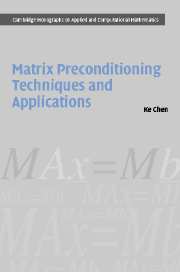Book contents
- Frontmatter
- Contents
- Preface
- Nomenclature
- 1 Introduction
- 2 Direct methods
- 3 Iterative methods
- 4 Matrix splitting preconditioners [T1]: direct approximation of An×n
- 5 Approximate inverse preconditioners [T2]: direct approximation of An×n−1
- 6 Multilevel methods and preconditioners [T3]: coarse grid approximation
- 7 Multilevel recursive Schur complements preconditioners [T4]
- 8 Sparse wavelet preconditioners [T5]: approximation of Ãn×n and Ãn×n−1
- 9 Wavelet Schur preconditioners [T6]
- 10 Implicit wavelet preconditioners [T7]
- 11 Application I: acoustic scattering modelling
- 12 Application II: coupled matrix problems
- 13 Application III: image restoration and inverse problems
- 14 Application IV: voltage stability in electrical power systems
- 15 Parallel computing by examples
- Appendix A a brief guide to linear algebra
- Appendix B the Harwell–Boeing (HB) data format
- Appendix C a brief guide to MATLAB®
- Appendix D list of supplied M-files and programs
- Appendix E list of selected scientific resources on Internet
- References
- Author Index
- Subject Index
- Plate section
4 - Matrix splitting preconditioners [T1]: direct approximation of An×n
Published online by Cambridge University Press: 06 January 2010
- Frontmatter
- Contents
- Preface
- Nomenclature
- 1 Introduction
- 2 Direct methods
- 3 Iterative methods
- 4 Matrix splitting preconditioners [T1]: direct approximation of An×n
- 5 Approximate inverse preconditioners [T2]: direct approximation of An×n−1
- 6 Multilevel methods and preconditioners [T3]: coarse grid approximation
- 7 Multilevel recursive Schur complements preconditioners [T4]
- 8 Sparse wavelet preconditioners [T5]: approximation of Ãn×n and Ãn×n−1
- 9 Wavelet Schur preconditioners [T6]
- 10 Implicit wavelet preconditioners [T7]
- 11 Application I: acoustic scattering modelling
- 12 Application II: coupled matrix problems
- 13 Application III: image restoration and inverse problems
- 14 Application IV: voltage stability in electrical power systems
- 15 Parallel computing by examples
- Appendix A a brief guide to linear algebra
- Appendix B the Harwell–Boeing (HB) data format
- Appendix C a brief guide to MATLAB®
- Appendix D list of supplied M-files and programs
- Appendix E list of selected scientific resources on Internet
- References
- Author Index
- Subject Index
- Plate section
Summary
The term “preconditioning” appears to have been used for the first time in 1948 by Turing [461], … The first use of the term in connection with iterative methods is found in a paper by Evans [200] … in 1968.
Michele Benzi. Journal of Computational Physics, Vol. 182 (2002)For such problems, the coefficient matrix A is often highly nonsymmetric and non-diagonally dominant and hence many classical preconditioning techniques are not effective. For these problems, the circulant preconditioners are often the only ones that work.
Raymond Chan and Tony Chan. Journal of Numerical Linear Algebra and Applications, Vol. 1 (1992)In ending this book with the subject of preconditioners, we find ourselves at the philosophical center of the scientific computing of the future … Nothing will be more central to computational science in the next century than the art of transforming a problem that appears intractable into another whose solution can be approximated rapidly. For Krylov subspace matrix iterations, this is preconditioning.
Lloyd Nicholas Trefethen and David Bau III. Numerical Linear Algebra. SIAM Publications (1997)Starting from this chapter, we shall first describe various preconditioning techniques that are based on manipulation of a given matrix. These are classified into four categories: direct matrix extraction (or operator splitting type), inverse approximation (or inverse operator splitting type), multilevel Schur complements and multi-level operator splitting (multilevel methods).
- Type
- Chapter
- Information
- Matrix Preconditioning Techniques and Applications , pp. 165 - 190Publisher: Cambridge University PressPrint publication year: 2005



